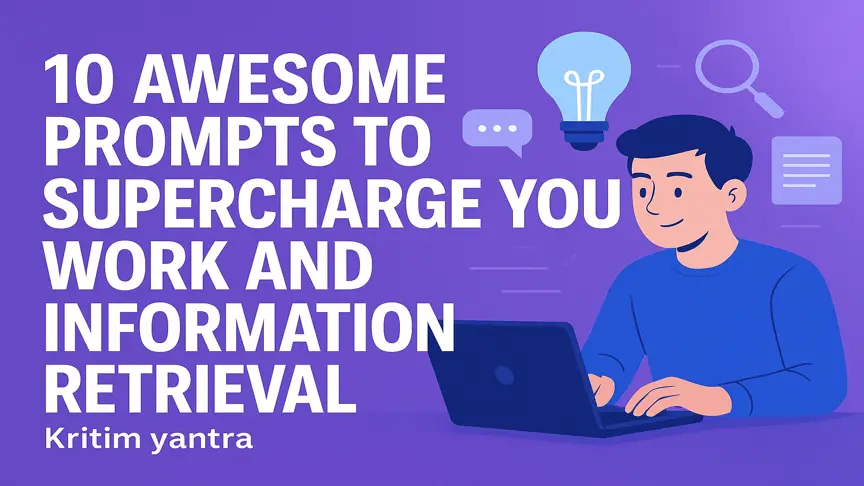Understanding AI Agents: The Simple Guide You’ve Been Waiting For

Kritim Yantra
Apr 14, 2025
Artificial Intelligence (AI) is everywhere today — from voice assistants like Siri and Alexa to self-driving cars. But behind the scenes of many powerful AI systems is something called an AI agent. If you're new to this concept, don’t worry — in this blog, we’ll break it down into simple language and explain everything you need to know about AI agents.
🧠 What is an AI Agent?
An AI agent is like a smart software robot that can observe, think, and act to achieve a goal.
Think of it like a virtual assistant that:
- Sees what’s happening around it (this is called perceiving),
- Understands the situation,
- Decides what to do next,
- Takes action to solve a problem or reach a goal.
🔁 This cycle is called: Perceive → Decide → Act
👀 Real-World Example: AI Agent in Action
Let’s take a robot vacuum cleaner as an example.
🧹 How it works as an AI agent:
- Perceives: Uses sensors to detect furniture, walls, and dirt.
- Thinks: Decides the best path to clean the floor.
- Acts: Moves in a smart way to clean without bumping into things.
It keeps repeating this process until the floor is clean — that’s an AI agent in action!
⚙️ Key Parts of an AI Agent
Here are the basic components that make up an AI agent:
1. Environment
The world the agent lives in. For the vacuum, it's your room. For a chatbot, it's the conversation.
2. Sensors
How it gets information. Just like our eyes and ears, AI agents use sensors like cameras, microphones, or data inputs.
3. Actuators
How it acts. This could be wheels, arms, or even code that sends messages or clicks buttons.
4. Agent Function (or Brain)
This is the intelligence of the agent. It decides what to do based on the data it receives.
🧩 Types of AI Agents
Not all agents are the same. Some are very simple, and others are super smart.
1. Simple Reflex Agents
They react based on rules. Example: If it sees an obstacle, stop.
2. Model-Based Agents
They remember past events. Example: They know where they’ve already cleaned.
3. Goal-Based Agents
They aim to reach a goal. Example: Navigate a maze to find the exit.
4. Utility-Based Agents
They choose the best outcome. Example: Choose the fastest, safest route.
5. Learning Agents
They get better over time. Example: Chatbots that improve with more conversations.
💡 Where Are AI Agents Used Today?
AI agents are used in many areas:
| Use Case | How AI Agent Helps |
|---|---|
| 🧠 Virtual Assistants | Understands your voice and responds |
| 🚗 Self-Driving Cars | Detects roads, signs, and traffic |
| 🧹 Smart Home Devices | Adjusts temperature, cleans rooms |
| 📞 Chatbots | Answers customer questions |
| 🏥 Healthcare | Suggests treatments and diagnoses |
| 🎮 Games | Makes game characters act smart |
🧬 How Do They Learn?
Many modern AI agents use a technique called Machine Learning. This means they learn from experience, just like humans.
For example:
- A chatbot improves after handling hundreds of questions.
- A robot learns to walk better after trying many times.
📊 AI Agent vs Traditional Software
| Feature | AI Agent | Traditional Software |
|---|---|---|
| Learns from data | ✅ Yes | ❌ No |
| Adapts to changes | ✅ Yes | ❌ No |
| Acts on its own | ✅ Yes | ❌ No |
| Fixed instructions | ❌ No | ✅ Yes |
🚀 The Future of AI Agents
AI agents are becoming smarter, faster, and more helpful. In the future, they could:
- Work as personal life assistants
- Manage entire factories
- Help scientists discover new medicines
- Handle customer service 24/7
- Be companions for the elderly or disabled
🧠 Final Thoughts
An AI agent is more than just a robot — it’s a smart decision-maker that can help in all areas of life. From cleaning floors to helping doctors, AI agents are shaping the future.
💬 In Simple Words:
An AI agent is like a smart helper that sees, thinks, and acts — all on its own!
Comments
No comments yet. Be the first to comment!
Please log in to post a comment:
Sign in with GoogleRelated Posts
 Kritim Yantra
Kritim Yantra

 Kritim Yantra
Kritim Yantra
